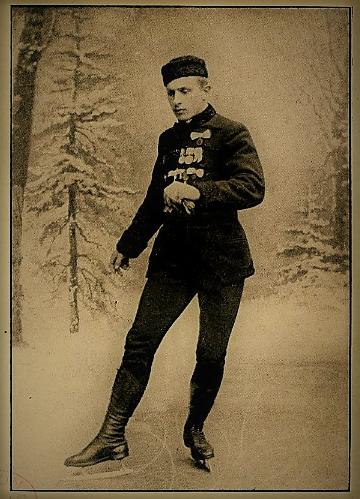Just over ten years prior to the grisly Hallowe'en Holocaust that claimed dozens of lives at a Holiday On Ice show in Indiana in 1963, a similarly gruesome accident occurred at an ice show that starred none other than three time Olympic Gold Medallist and ten time World Champion Sonja Henie.
The date was Thursday, March 6, 1952 and a crowd of seven thousand had amassed in Baltimore, Maryland for the Sonja Henie Ice Revue. The skaters were backstage, ready to take the ice, when five minutes before the 8:30 PM show was set to begin, a section of hastily constructed bleachers in Baltimore's fifth regiment armoury came crashing to the ground, spectators and all. The March 7, 1952 edition of the "Milwaukee Journal" reported, "The heavy beams and planks went down with a roar, pinning men, women and children under a mass of heavy splinters. Men tore at the tangled beams to rescue screaming children and crying women. There was no panic among others in the crowd, and the rescue operation carried on by police, firemen and national guardsmen was completed within thirty minutes." A staggering two hundred and seventy seven people were injured in the accident, sent to ten different hospitals in the area. As of the next day, thirty two of those victims were in serious condition.
The cause of the accident was determined to be shoddy craftsmanship. The makeshift bleachers were reportedly not even nailed down properly. To top it all off, the armoury had been exempt from even requiring a building permit because it was 'state property'. The tour had applied for one anyway and been refused by building inspector Paul Cohen because the stands weren't even finished when the application was put in only hours before the accident. Cohen confirmed that a permit would not have been issued as the stands were "of temporary construction and not even nailed down."
An eyewitness account from Kenny Lamb, one of the skaters in Henie's tour (submitted to "Lucidcafé" in the nineties) reads: "While we were rehearsing for the show we watched a work crew erecting some extra bleacher seats. We noticed they were working very clumsily and didn't look very skilled but figured they knew what they were doing. Were we ever wrong! As the [overture] for the show began, we heard a strange screeching sound and then a roar. The roar was the sound of a thousand seats, filled with people, crashing eighteen feet to the floor! They were sitting in the bleachers that had been hastily built during our rehearsal! The screeching was the nails being pulled out of the wood! Since we were playing in an armoury there was immediate first aid provided by National Guard personnel. The guardsmen had to break down doors from the outside to help the victims who were trapped down in what was now a pit-like area. Sonja had the orchestra play quietly until the people involved were taken out for first aid and to hospitals. At about 9:30 the stage manager came up to Sonja and said 'shall we start the show now?' Sonja just looked at him and said two words, 'You're fired!' She then stayed up all night visiting the injured victims that were hospitalized over night, about fifty in all. There were about two hundred injured but thankfully no deaths. She delayed starting the show for three days, doing everything possible to help the victims. She was like that, and we loved her for it."
Henie's concern and well wishes were all well and good, but the people of Maryland were appalled. Governor Theodore R. McKeldin attended the armoury shortly after the accident, referring to the tragedy as "an outrage" and demanded that Mayor Thomas D'Alesandro organize a thorough inquiry into what caused the accident. Quoted in the March 7, 1952 edition of the "Spokane Daily Chronicle", Mayor D'Alesandro said the city would work with state groups and go through the wreckage "timber by timber and joint by joint." The investigation revealed that the shoddy stands were constructed by a contracting firm from Westfield, New Jersey owned by a Mr. Ed Coronati, whose background was in constructing seating for circuses, fairs and other events. He'd even designed bleachers at the same armoury before.
Courtesy of the Boston Public Library, Leslie Jones Collection. Used with permission.
Five million dollars is a huge amount of money these days obviously, but if you put that amount in the context of the early fifties, it's really no shocker that by the next year, Henie was moving onto a new venture with Morris Chalfen and Holiday On Ice in Europe. You also have to remember that by this point, in addition to Ice Capades and Ice Follies as well as many hotel shows all over the U.S., Henie was at that point in direct competition with the next big star in North America, Barbara Ann Scott. It's almost unbelievable to think though that not a single person died as the result of that completely avoidable accident. The moral of the story? Sometimes being a spectator at a skating show can be even more dangerous than being a performer.
Skate Guard is a blog dedicated to preserving the rich, colourful and fascinating history of figure skating. Over ten years, the blog has featured over a thousand free articles covering all aspects of the sport's history, as well as four compelling in-depth features. To read the latest articles, follow the blog on Facebook, Twitter, Pinterest and YouTube. If you enjoy Skate Guard, please show your support for this archive by ordering a copy of the figure skating reference books "The Almanac of Canadian Figure Skating", "Technical Merit: A History of Figure Skating Jumps" and "A Bibliography of Figure Skating": https://skateguard1.blogspot.com/p/buy-book.html.
















































